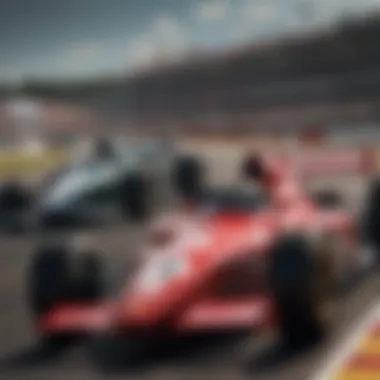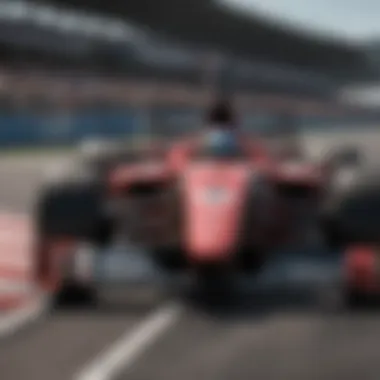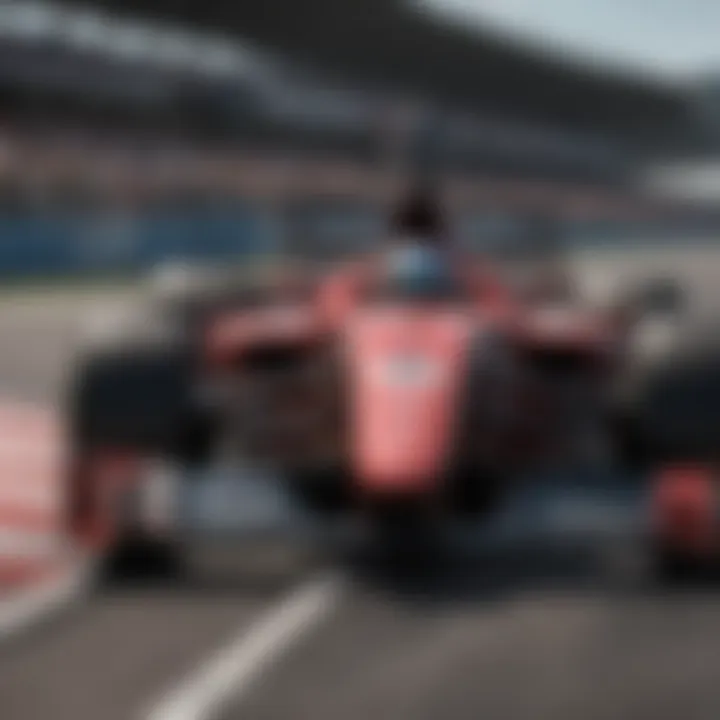Exploring the American Grand Prix: Insights into Racing History
Intro
The American Grand Prix stands as a monumental fixture in the pantheon of motorsport events, weaving together threads of history, competition, and technological evolution. This race, deeply etched in the landscape of automotive culture, offers more than just high-speed thrills. For racing buffs, it’s a treasure trove of stories—moments when the roar of engines announced victories, losses, and the relentless pursuit of excellence.
With increasing focus on sustainability and innovation, the Grand Prix not only showcases how far the industry has come but also how it continually looks ahead. The fusion of diverse elements—from engineering prowess to driver charisma—paints a complex picture of what this event really represents. In this article, we will peel back the layers and dive into multiple aspects of the American Grand Prix, providing detailed insights that resonate with both car enthusiasts and casual observers alike.
As we embark on this journey, expect to see:
- A thorough examination of the race's storied history
- Insights on how it shapes car culture in the U.S.
- Analyzing the impact of emerging technologies in automotive racing
Join us as we navigate through these topics, offering a comprehensive lens through which to understand the significance of the American Grand Prix.
Historical Context of the American Grand Prix
Understanding the historical context of the American Grand Prix is vital to appreciating its standing in the automotive racing world today. This race has not only shaped the landscape of motorsport in the United States but also reflected broader social and technological changes. The Grand Prix serves as a mirror, revealing shifts in public interest and the evolution of car culture, which in turn frames the very nature of competition on the track.
Origins of the Event
The American Grand Prix, like many events in motorsport, has its roots planted deep in the early 20th century. It initially emerged from the thrill of early motor racing, where local and regional competitions laid the groundwork. The first official race that can be closely associated with what we consider the Grand Prix came about in 1908. The New York to Paris race featured cars from various manufacturers, showcasing not just speed but also endurance across diverse terrains and weather conditions. While this particular event was not labeled specifically as a Grand Prix, it set the stage for organized, competitive racing in the U.S.
By the 1950s, the American Grand Prix began to formalize its structure, largely thanks to the influence of European motorsport. Engaging local crowds and establishing itself on the international stage, the race found a home at the renowned Watkins Glen International in New York. The venue's reputation grew, and in 1961, it officially joined the Formula One calendar, marking a significant shift as the American Grand Prix began attracting both international competitors and a burgeoning fan base.
Milestones and Landmark Races
The journey of the American Grand Prix has been punctuated by momentous occasions that have etched themselves into the annals of racing history. Take, for example, the 1973 American Grand Prix where the legendary driver Jackie Stewart claimed victory amidst heavy rain. This race left an indelible mark not only due to the challenging conditions, but also for the discussions it spurred on race safety.
Moreover, the event witnessed the rise of iconic rivalries. The late 1980s and early 90s saw a fierce competition between Alain Prost and Ayrton Senna, which transformed the sport's landscape and captivated fans worldwide. Their battles added drama and intensity, giving the American Grand Prix not just a European flair but also a unique American character.
Some significant milestones include:
- The 1976 race, celebrated for the fierce weather that forced teams to re-strategize mid-race.
- The 2000 race, which marked the debut of the new Millennial generation of racing technology.
- The 2012 race, marking a resurgence of interest in Formula One racing within the United States.
Each of these moments contributed to a narrative of resilience and advancement in racing standards.
Transition Periods in the Late 20th Century
As the American Grand Prix flowed into the late 20th century, the sport underwent myriad transitions. The rise of technology, changes in regulations, and shifting audience interests posed both challenges and opportunities for the event. During the 1990s, the popularity of IndyCar racing surged, at times overshadowing Formula One in the American market. However, the unique cachet of the Grand Prix, combined with its international appeal, ensured that it maintained a loyal fanbase.
In 1991, the Grand Prix found its way back to the Central New Jersey and continued flourishing until challenges arose towards the late 90s. Economic downturns and shifting sponsorship landscapes forced organizers to rethink their strategies and locations. The failure of races in cities like Phoenix demonstrated the need for a more sustainable approach.
Eventually, things turned around when the sport found renewed energy in the early 2000s. With the introduction of new venues like the Circuit of the Americas in Austin, the event carved out a fresh identity, one that embraced both its storied past and its future potential. This blending of old and new showcases the race as something more than just a competition—it's a rich tapestry woven with threads of history, culture, and technology.
"The evolution of American motorsport is a reflection of the country's broader cultural and technological shifts—where the thrill of speed is matched only by the machine itself."
Current Format and Structure


Understanding the current format and structure of the American Grand Prix is crucial not just for fans but also for stakeholders, sponsors, and potential participants. The race has undergone various transformations and continues to evolve, reflecting the shifting dynamics of motorsports. Today, the format is a blend of tradition and innovation, aimed at enhancing viewer experience and competitive fairness.
Race Format and Schedule
The race format itself has seen some changes over the years. Currently, the American Grand Prix typically unfolds over the course of three days, a setup familiar to fans of Formula One. Which includes:
- Practice Sessions: Two practice sessions are held prior to qualifying, where teams fine-tune their cars and drivers familiarize themselves with the track.
- Qualifying: This crucial session sorts the grid for the race. The fastest lap in qualifying ensures pole position, giving that driver a significant advantage.
- The Race: Finally, the main event spans anywhere from 56 to 70 laps, depending on the circuit length with regulations ensuring that each race is full of competitive spirit and strategic racing.
The schedule is meticulously planned to optimize both driver preparation and audience engagement. It often coincides with other large-scale automotive events or festivals, maximizing spectator interest. Additionally, the American Grand Prix is sometimes a part of a broader championship series, ensuring both national and international participation.
Key Participants and Teams
At the heart of the Grand Prix are its participants—drivers, teams, engineers, and support staff—each playing an integral role in the execution of the race. Prominent teams that have made their mark include Scuderia Ferrari, known for their long-standing legacy, and Mercedes-AMG Petronas, famed for their recent dominance in Formula One.
The drivers themselves often become legends, with names like Lewis Hamilton and Sebastian Vettel drawing massive fanfare. Such key figures bring not only skill but also charisma, which significantly elevates the race's profile.
Furthermore, the role of new teams cannot be dismissed. Emerging squads like Alpine and AlphaTauri are slowly carving their niche into the competitive landscape, often introducing fresh strategies and innovative designs, thereby shaking up the established order and enhancing overall competition.
Role of Technology in Racing
The integration of technology has dramatically altered the fabric of racing in the American Grand Prix. Gone are the days when it was merely about the driver’s instinct and sheer horsepower; now, technology plays a pivotal role in performance and safety.
For instance, advancements in telemetry allow teams to gather real-time data from cars, enabling instantaneous decision-making during the race. Simulation software is also revolutionizing driver training, preparing them for the demands of high-pressure environments.
Furthermore, technologies such as DRS (Drag Reduction System) and various tire compounds provide strategic elements to the race. The complexity of each component, from aerodynamics to engines, showcases how racing is scientifically optimized today. Safety innovations, stemming from high-speed crashes, continually shape regulations and design, ensuring the event evolves with the times while prioritizing driver safety.
"The marriage of technology and speed creates a unique spectacle, reflecting not just human skill but also mechanical artistry."
In summary, the current format and structure of the American Grand Prix encapsulates a blend of rich tradition and cutting-edge innovation, making it a fascinating subject for both casual fans and seasoned automotive enthusiasts alike.
Cultural Significance of the American Grand Prix
The American Grand Prix stands as more than just a racing event; it forms an integral thread in the cultural fabric of the United States. This significance can be seen in various dimensions, from shaping automobile enthusiasm to influencing societal views towards racing and speed.
Impact on American Car Culture
When one reflects on the American car culture, it’s clear that the Grand Prix has played a seminal role. Since its inception, it has brought high-performance vehicles to the forefront of public admiration. The roar of engines and the sight of cars flying around the track resonate deeply with enthusiasts. This spectacle transforms mundane automobile functionality into a vibrant symbol of freedom, innovation, and status.
Consider this: every time a bright red Ferrari speeds through a corner, it prompts curiosity and inspires younger generations to aspire towards driving and owning such magnificent machines. The event acts as a showcase, where legendary figures like Mario Andretti or Dale Earnhardt Jr. become heroes, reinforcing the idea that speed and skill can reshape one’s destiny.
Media Representation and Popularity
Media representation plays a crucial role in propelling the American Grand Prix into pop culture. Broadcasters like NBC Sports and Fox Sports provide extensive coverage, marketing it not just as a race, but as an event that captivates millions. From reality shows spotlighting celebrity drivers to online platforms like Reddit and Facebook for discussions, the narrative has expanded beyond just enthusiasts.
This representation is pivotal. A thrilling race can lead to viral moments, often shared on social media platforms. For instance, iconic crashes or daring overtakes can sway public interest, drawing a wider audience who might have previously been indifferent to motorsport. The spectacle of fast cars and glamorous drivers fills stadiums and living rooms alike, bridging gaps between casual fans and hardcore zealots.
"The car depicted how America envisioned itself—fast, powerful, and free. The Grand Prix embodies much of that spirit."


Role in Shaping Automotive Trends
The American Grand Prix doesn't only impact culture— its reach extends into the very bones of automotive development. Each race often serves as a testing ground for innovations that trickle down to consumer vehicles. Consider elements like advanced aerodynamics, hybrid powertrains, or even tire technology. These advancements are not just fun to watch; they directly influence what we drive on the roads today.
With brands like Tesla continually redefining standards, the Grand Prix nurtures an environment of competition that encourages innovation across manufacturers. The pressure to outperform leads to breakthroughs that change how cars are designed and built. In essence, racing stirs the pot of creativity, resulting in safer, more efficient vehicles.
Technological Innovations in Racing
Technological innovations have always been the backbone of motorsport. In the American Grand Prix, these advancements not only enhance performance but also trickle down into everyday vehicles. Understanding the nuances of these technologies can help both enthusiasts and casual fans appreciate the depth of engineering involved in racing.
Advancements in Engine Technology
When we speak of racing engines, it’s about pushing limits and redefining power. Recent years have seen significant strides in engine technology, particularly in the realm of hybrid systems. Hybrid engines combine traditional combustion engines with electric power, which offers both efficiency and heightened performance. This technology not only reduces fuel consumption but also optimizes torque, making acceleration astonishingly rapid.
Moreover, there’s the introduction of variable valve timing and turbocharging, which enhance engine responsiveness. Many manufacturers, like Mercedes-Benz, have pioneered these concepts, leading to engines that are more powerful yet lighter, a necessary advantage on the track.
"The best defense against a faster car is an even faster one—engine enhancements can make that a reality."
Contribution of Aerodynamics to Performance
Aerodynamics in racing can be likened to the wind itself, shaping how a car interacts with its environment. The design of a race car's body often dictates its success on the track. Companies invest heavily in wind tunnel testing to optimize shapes that minimize drag and maximize downforce.
Features like front and rear spoilers, diffusers, and streamlined bodies work in harmony to stabilize vehicles at high speeds. For example, the way a vehicle's surface is sculpted can lead to significant performance gains, allowing cars to cut through the air while remaining glued to the track.
A notable case would be the McLaren racing team, which continuously innovates with aerodynamic upgrades, showing how crucial this aspect is to stay ahead in competitive racing.
Safety Innovations Derived from Racing
Safety in motorsport may seem like an afterthought, but the American Grand Prix has driven many innovations that have made racing safer. Technologies developed for racing often find their way into consumer vehicle safety features. The introduction of reinforced cockpits and crumple zones, for instance, ensures drivers have a better chance during a crash.
Furthermore, advancements like the HANS device (Head and Neck Support) have become standard equipment, significantly reducing the risk of head injuries during collisions.
Moreover, improvements in tire technology have led to better grip and handling, while systems designed for rapid fire suppression in case of accidents are now commonplace. The knowledge and practices honed on the race track have undoubtedly influenced the safety features of the cars we drive daily.
Economic Impact of the Grand Prix
The American Grand Prix isn’t just an exciting spectacle for racing fans; its economic implications resonate beyond the racetrack, influencing local economies and attracting substantial investment. In an era where financial resources can determine the viability of such high-profile events, the Grand Prix stands out as a beacon of economic activity, drawing in visitors, sponsors, and intense media attention. This section will provide a thorough look into two critical aspects of its economic footprint: revenue generation for local economies and current trends in sponsorship and investment.
Revenue Generation for Local Economies
One cannot help but notice the hustle and bustle surrounding the American Grand Prix. This event acts as a catalyst for local businesses, creating a ripple effect that boosts various sectors, including hotel accommodations, hospitality services, and retail markets. With an influx of thousands of racing enthusiasts—many traveling from far-flung corners of the country—local businesses see significant profit.
- Hospitality Industry: Local hotels and motels, often filled to capacity for the occasion, reap the benefits of increased bookings. Not to get lost in the details, however, many establishments offer special packages to entice visitors who want the full Grand Prix experience. Families enjoy afternoon barbecues and formal gala events, all while feeling the reverberations of race cars zooming on the track.
- Restaurants and Cafes: Eateries experience boosts as fans flock to taste local cuisine after long days of racing. Many restaurants even roll out themed menus or special offers during the race weekend, creating a festive atmosphere that resonates with attendees.
- Merchants and Retailers: Local vendors often capitalize by setting up booths to sell race-related memorabilia, apparel, or even food. If you’ve ever been to a race, you know the allure of that freshly painted souvenir mug or a flashy T-shirt that bears the year's designs.
Equally important is the impact on public transportation systems. Increased ridership during the event ensures that transportation providers can make a profit, while also prompting city planners to enhance infrastructure for future events. In short, the Grand Prix transforms the whole region economically, leaving behind a positive aftertaste long after the last car has crossed the finish line.
Sponsorship and Investment Trends


The financial muscle behind the American Grand Prix primarily comes from its ability to attract sponsorship deals from reputable companies. Automobile manufacturers, tire suppliers, and telecommunication giants often clamour for visibility, knowing full well that the race provides an unparalleled platform to showcase their products to a captive audience.
- Brands Associated with Performance: Names like Pirelli and Mercedes-Benz are heavily ingrained in the racing culture, showcasing their latest technologies amid the high-speed action. These partnerships not only elevate brand visibility but also translate to significant marketing investments.
- Expand to Non-Automotive Sectors: Interestingly, sponsors don't always hail from automotive backgrounds. Tech companies and fast-food chains frequently line up as sponsors, hoping to connect with the audience in a relaxed yet thrilling environment. For them, it’s about grabbing attention and pushing new offerings in a lively context.
Investment in the Grand Prix also opens several doors—ranging from circuit enhancements to fan engagement initiatives. Efforts to foster a better environment for fans often translate to longer event engagements and increased satisfaction, which, in turn, curls back to a higher likelihood of repeat attendance.
The economic fabric woven around the American Grand Prix showcases a complex interdependency, where local economies thrive under the shadow of roaring engines and spirited competition.
To sum it up, the anchoring of the Grand Prix to local economies isn’t merely a bonus; it's a lifeline that injects resources into communities, pushing growth and further engagement. As we look ahead, understanding these economic trends will pave the way for more informed discussions about the future of this iconic race.
Future of the American Grand Prix
The landscape of motorsport is ever-evolving, and the American Grand Prix is no exception. As the automotive world shifts gears into new territories, it's imperative to examine what lies ahead for this iconic race. Considering the potential for change across various dimensions—from technological advancements to fan engagement, the future landscape is a topic of considerable relevance. How this prestigious event adapts can dictate its survival and prominence in the ever-competitive racing calendar.
Challenges Facing the Event
The American Grand Prix is not without its hurdles. One of the most pressing issues is maintaining a steady audience amid a constantly changing entertainment landscape, where distractions are as numerous as the stars in the sky. As motorsport enthusiasts become more invested in digital experiences, there's a palpable concern about dwindling live attendance. This change is exacerbated by the increasing costs associated with hosting such large-scale events. Cities and venues must step forth to cover expenses that seem to inflate annually.
Moreover, regulatory and environmental standards are climbing higher. While the push for greener technology is positive, it poses a challenge for teams accustomed to traditional racing standards. The need for sustainable practices may demand significant overhauls that not all teams are prepared to tackle just yet.
Emerging Trends and Innovations
Against the backdrop of these challenges, we see a host of trends surfacing that could redefine the American Grand Prix. Enhanced fan experiences, particularly through digital technology, are paving the way for new forms of engagement. Think about virtual reality: picture a fan experiencing a lap around the race track from the driver's perspective while sitting in their living room. It may sound far-flung, but initiatives like this are no longer in the realm of science fiction—they are shaping the future.
Another noteworthy trend is the shift towards electric vehicles in racing. With the rise of forms like Formula E, the American Grand Prix will need to consider how it can incorporate electric and hybrid technology into its identity. This could attract a newer breed of fans interested in sustainable racing.
"As we stand at the crossroads of tradition and technology, the choices made today will dictate the legacy of the American Grand Prix for generations to come."
Potential Changes in Format and Location
The traditional format of racing is being challenged by innovative concepts that could redefine the Grand Prix experience. Discussions surrounding alternative locations to host races are gaining traction. Cities like Denver and Portland are emerging as potential hosts, catering to a demographic that might be underserved by established venues like Circuit of the Americas.
Moreover, there’s speculation about race formats that might incorporate shorter, more dynamic events. This could engage audiences who typically shy away from longer races; intensity might draw more eyes to the screen, or butts to the seats. Over the years, the demand for quick, thrilling races has surged. The challenge will be balancing this with the essence of what makes the Grand Prix, well, the Grand Prix.
As the American Grand Prix continues forward, it must navigate these challenges and embrace new trends while remaining true to its rich heritage. The interplay between tradition and innovation is delicate, yet it could hold the key to unlocking a promising future.
Epilogue
The conclusion serves as a pivotal segment of this exploration into the American Grand Prix, weaving together the many threads that thread through its history, current practices, and future potential. It encapsulates the essence of what the Grand Prix means not just to race fans, but to the wider realm of automotive culture and industry.
In summarizing the key points discussed throughout this article, we reflect on how the American Grand Prix has evolved through historical milestones, tackled occurrences of technological advancements, and championed the development of a unique automotive identity within the United States. Moreover, its economic contributions to local economies provide a tangible testament to its influence, going beyond the roar of engines on the racetrack.
Summary of Key Points
- The American Grand Prix initially took shape against a backdrop of both competition and camaraderie within the automotive community.
- As the event gained fame, it marked significant milestones that not only showcased the prowess of drivers but also introduced innovations in both car design and safety standards.
- Today, the race format and participant dynamics reflect changing attitudes towards racing and environmental considerations, a nod to the challenges of our time.
- Looking ahead, the Grand Prix faces hurdles but also stands ready to embrace trends like electric vehicles, drawing fresh interest from younger generations.
"The race is not merely about speed; it fosters innovation within the industry, bridging the gap between manufacturers and enthusiasts."
Final Thoughts on the Race's Legacy
The legacy of the American Grand Prix transcends the immediate excitement of race day. It serves as a canvas upon which the continuous narrative of automotive innovation and competition is illustrated. As we navigate modern challenges, the Grand Prix remains a symbol of resilience and the pursuit for excellence. This event has been a cornerstone for engaging with technology, shaping consumer behavior, and influencing international racing standards.
In reflection, the Grand Prix isn’t just an event on a calendar; it signifies a deeper relationship between cars and culture. It challenges the perception of what a race can and should be, promising to inspire future generations to not only appreciate but also contribute to the ever-evolving world of automotive racing.







